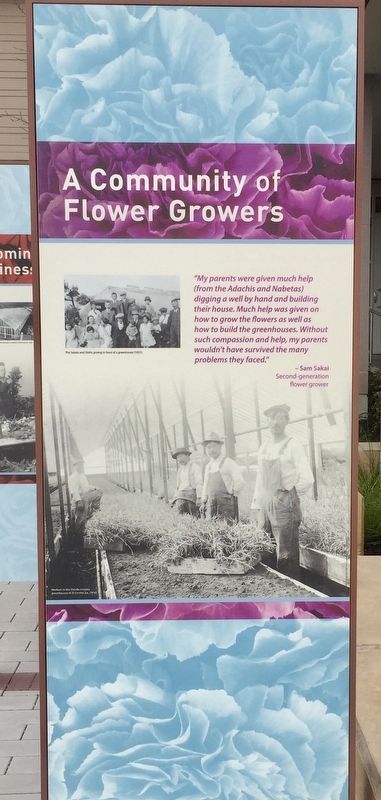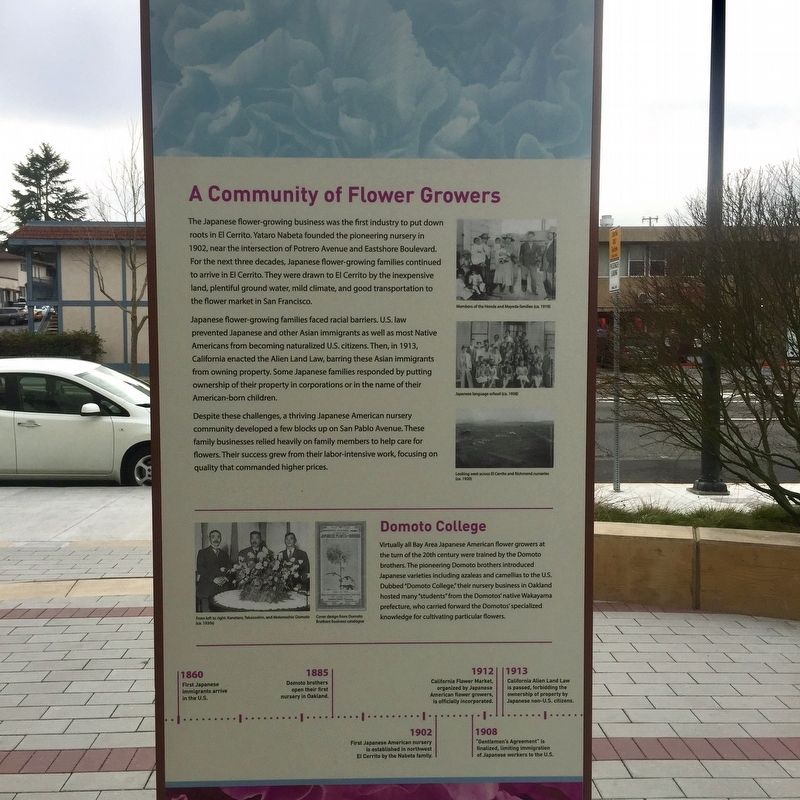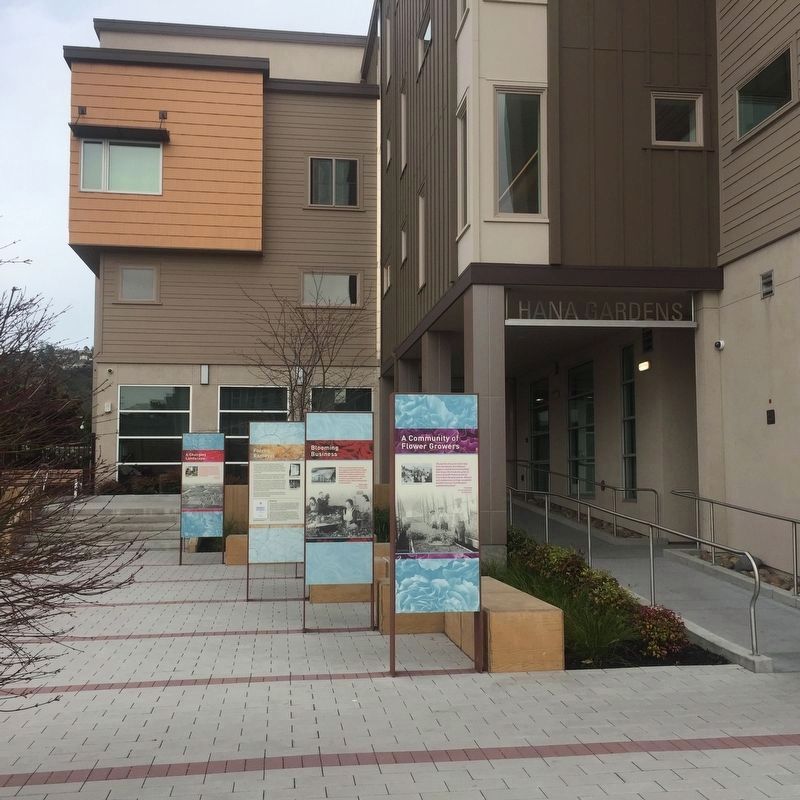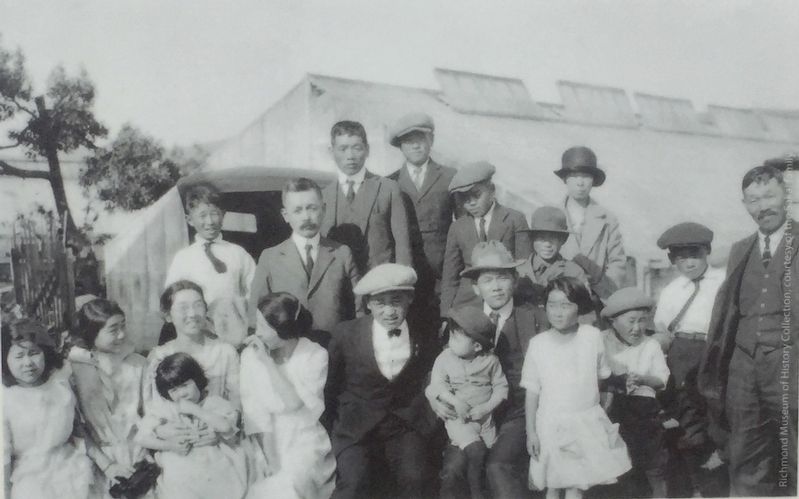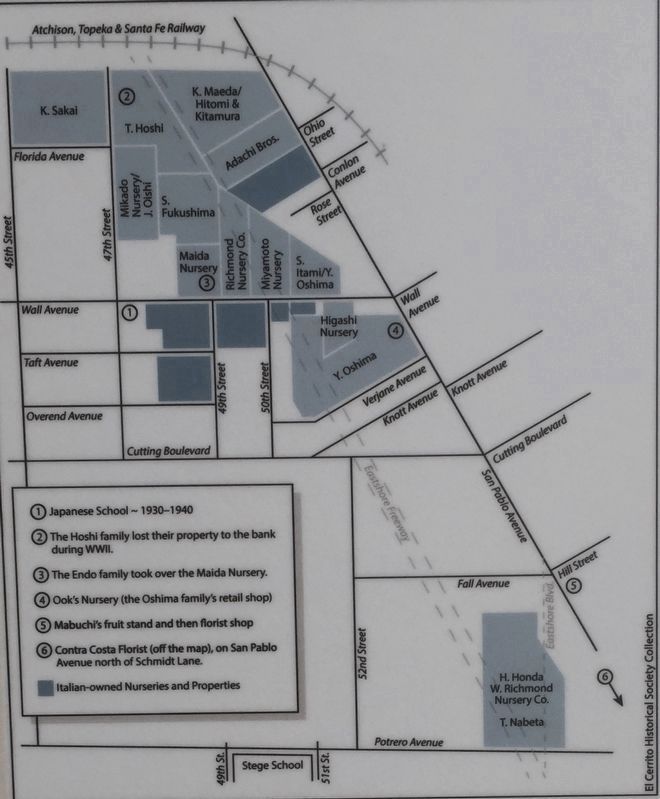A Community of Flower Growers
"My parents were given much help (from the Adachis and Nabetas) digging a well by hand and building their house. Much help was given on how to grow the flowers as well as how to build the greenhouses. Without such compassion and help, my parents wouldn't have survived the many problems they faced."
- Sam Sakai
Second-generation flower grower
(other or reverse side:)
The Japanese flower-growing business was the first industry to put down roots in El Cerrito. Yataro Nabeta founded the pioneering nursery in 1902, near the intersection of Potrero Avenue and Eastshore Boulevard. For the next three decades, Japanese flower-growing families continued to arrive in El Cerrito. They were drawn to El Cerrito by the inexpensive land, plentiful ground water, mild climate, and good transportation to the flower market in San Francisco.
Japanese flower-growing families faced racial barriers. U.S. law prevented Japanese and other Asian immigrants as well as most Native Americans from becoming naturalized U.S. citizens. Then, in 1913, California enacted the Alien Land Law, barring these Asian immigrants from owning property. Some Japanese families responded by putting ownership of their property in corporations or in the name of their American-born children.
Despite
these challenges, a thriving Japanese American nursery community developed a few blocks up on San Pablo Avenue. These family businesses relied heavily on family members to help care for flowers. Their success grew from their labor-intensive work, focusing on quality that commanded higher prices.
Domoto College
Virtually all Bay Area Japanese American flower growers at
the turn of the 20th century were trained by the Domoto
brothers. The pioneering Domoto brothers introduced
Japanese varieties including azaleas and camellias to the U.S.
Dubbed "Domoto College,” their nursery business in Oakland
hosted many "students” from the Domotos' native Wakayama
prefecture, who carried forward the Domotos' specialized knowledge for cultivating particular flowers.
-
(Timeline:)
1860 First Japanese immigrants arrive in the U.S.
1885 Domoto brothers open their first nursery in Oakland.
1902 First Japanese American is established in northwest El Cerrito by the Nabeta family.
1908 "Gentlemen's Agreement” is finalized, limiting immigration of Japanese workers to the U.S.
1912 California Flower Market, organized by Japanese American flower growers,
is officially incorporated.
1913 California Alien Land Law is passed, forbidding the ownership of property by Japanese
citizens.
Topics. This historical marker is listed in these topic lists: Agriculture • Asian Americans • Industry & Commerce. A significant historical year for this entry is 1902.
Location. 37° 54.919′ N, 122° 18.666′ W. Marker is in El Cerrito, California, in Contra Costa County. Marker is on San Pablo Avenue south of Manila Avenue, on the right when traveling north. Touch for map. Marker is at or near this postal address: 10860 San Pablo Avenue, El Cerrito CA 94530, United States of America. Touch for directions.
Other nearby markers. At least 8 other markers are within walking distance of this marker. Forced Removal (here, next to this marker); Blooming Business (a few steps from this marker); The Japanese in El Cerrito, a Timeline (a few steps from this marker); Contra Costa Florist (within shouting distance of this marker); City Hall (within shouting distance of this marker); Corridors of Change (within shouting distance of this marker); The Industrial Core (approx. ¼ mile away); Quarries (approx. ¼ mile away). Touch for a list and map of all markers in El Cerrito.
Credits. This page was last revised on March 1, 2020. It was originally submitted on February 29, 2020, by Andrew Ruppenstein of Lamorinda, California. This page has been viewed 230 times since then and 24 times this year. Photos: 1, 2. submitted on February 29, 2020, by Andrew Ruppenstein of Lamorinda, California. 3, 4, 5. submitted on March 1, 2020, by Andrew Ruppenstein of Lamorinda, California.
